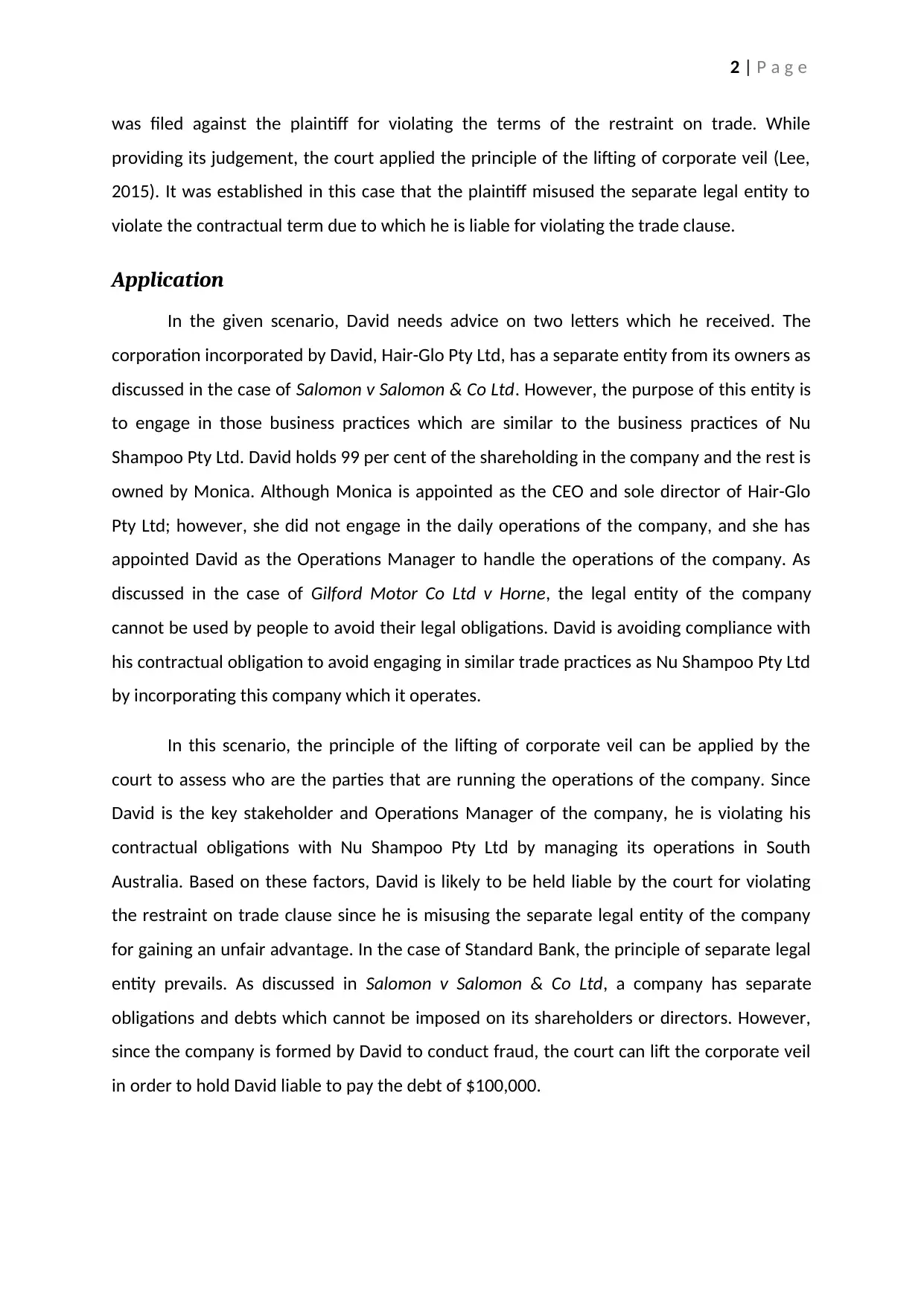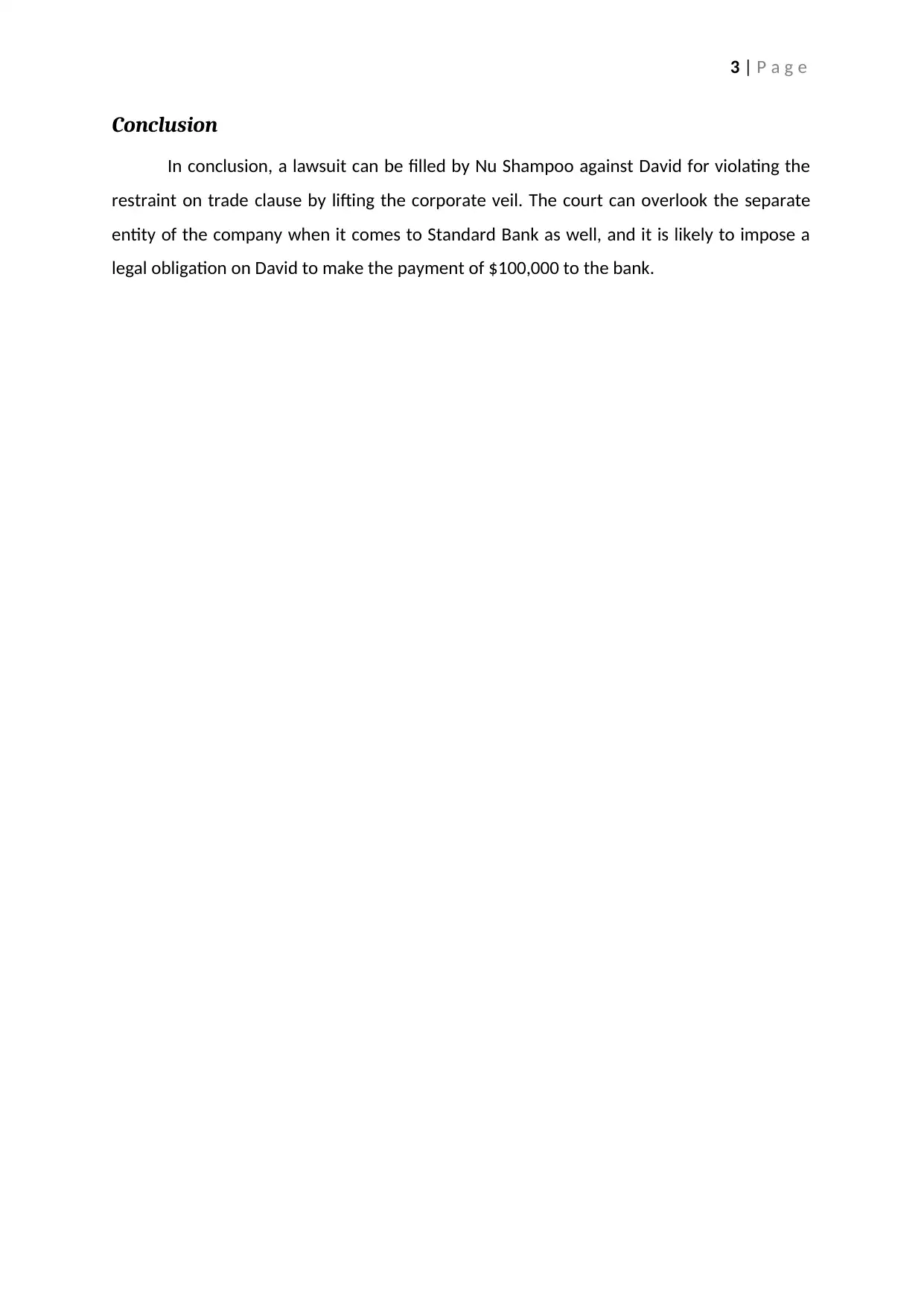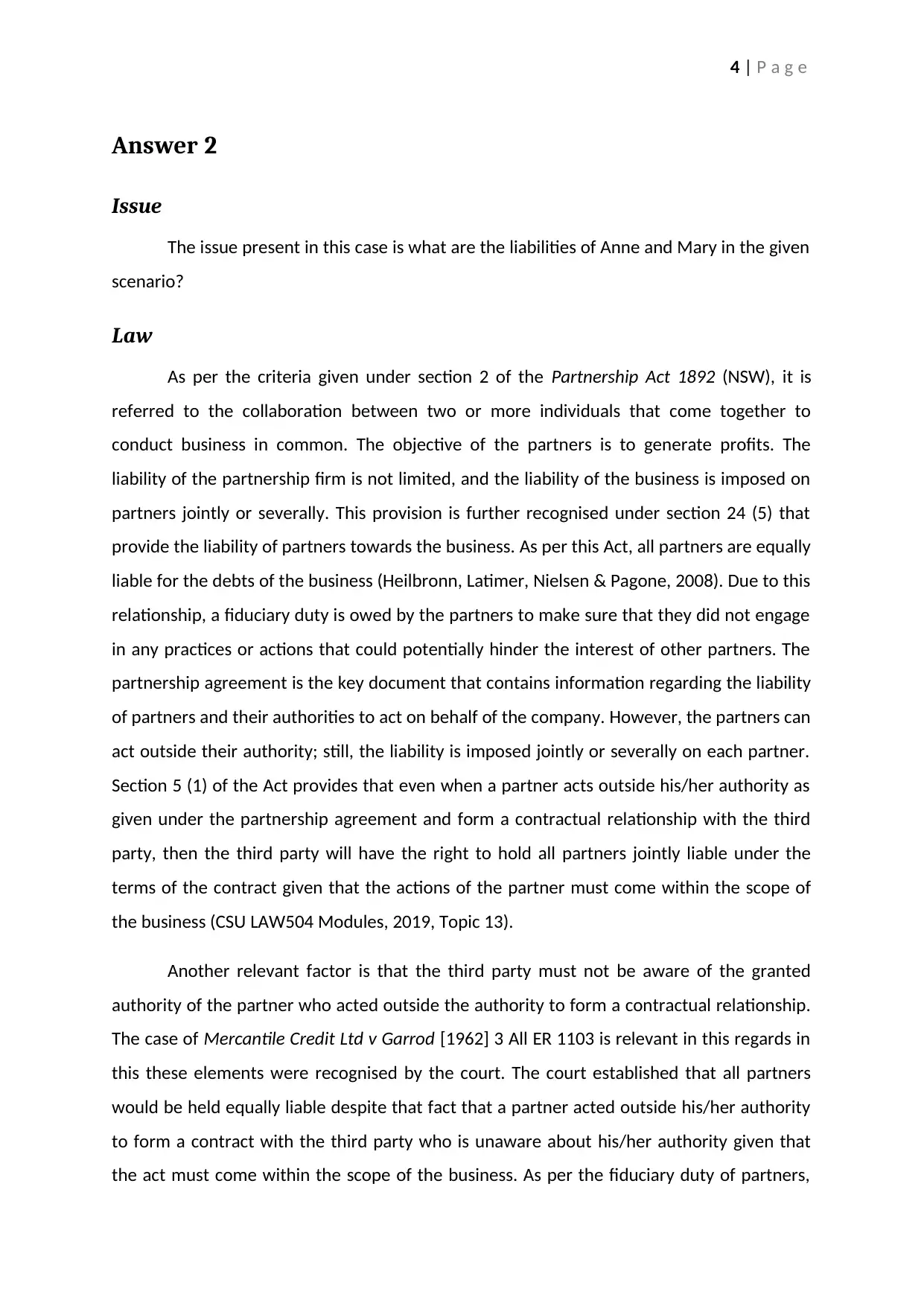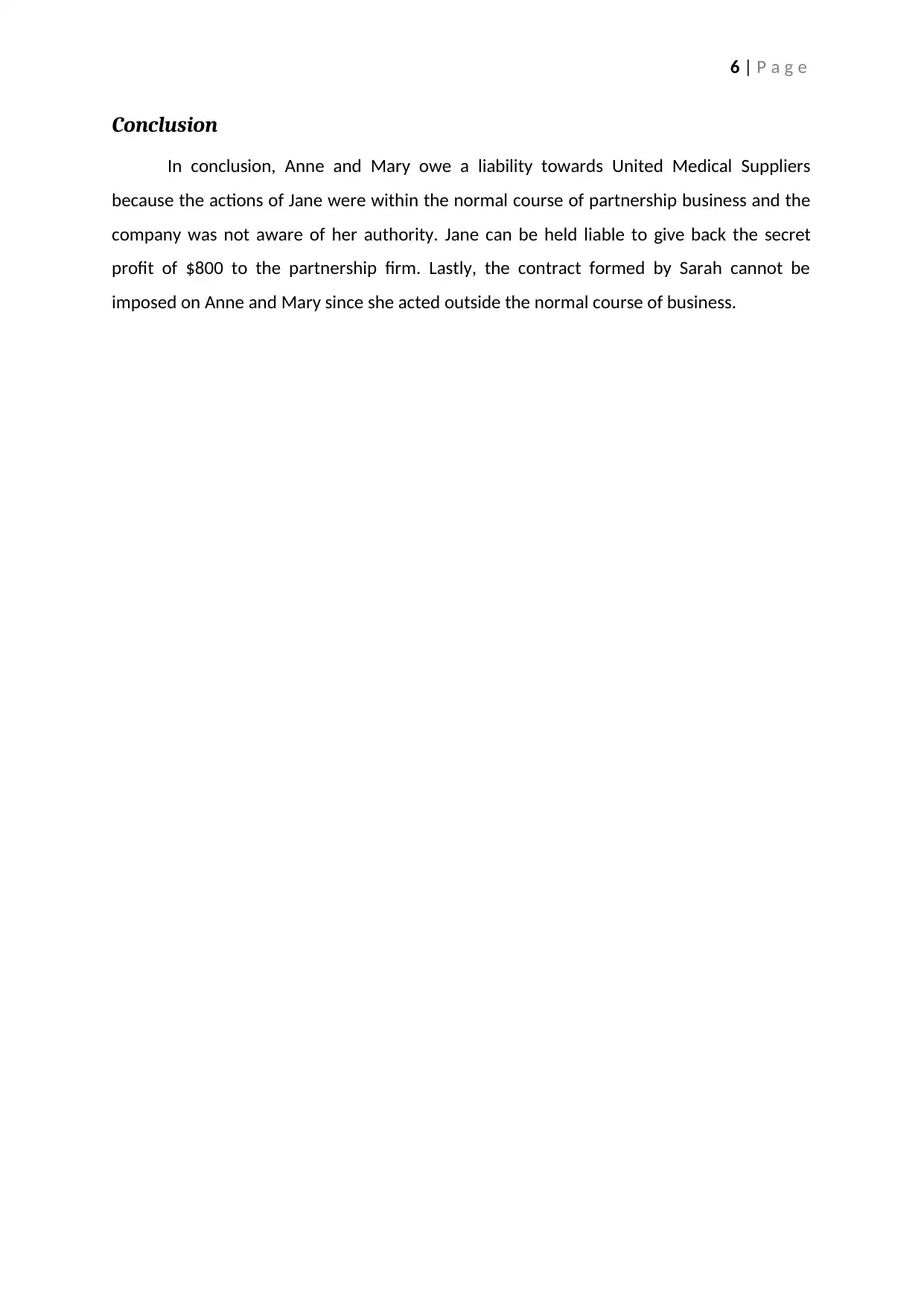Business and Corporation Law Assignment: Legal Issues and Analysis
VerifiedAdded on 2023/01/10
|8
|2081
|52
Homework Assignment
AI Summary
This assignment solution addresses two legal issues within business and corporation law. The first issue involves Nu Shampoo Pty Ltd's potential lawsuit against David for violating a restraint of trade clause and David's liability to Standard Bank. The analysis covers the legal personality of a company, the principle of the corporate veil established in Salomon v Salomon & Co Ltd, and the lifting of the corporate veil as seen in Gilford Motor Co Ltd v Horne. The second issue concerns the liabilities of Anne, and Mary within a partnership. The solution explores partnership formation, partner liabilities under the Partnership Act 1892 (NSW), fiduciary duties, and the implications of partners acting beyond their authority, referencing cases like Mercantile Credit Ltd v Garrod, Christie v Harcourt, and Birtchnell v Equity Trustee. The assignment concludes with the application of these legal principles to the given scenarios and provides reasoned conclusions on the liabilities of the parties involved.

0 | P a g e
Business and Corporation Law
Business and Corporation Law
Paraphrase This Document
Need a fresh take? Get an instant paraphrase of this document with our AI Paraphraser

1 | P a g e
Answer 1
Issue
The issue presented in this case is whether Nu Shampoo Pty Ltd can file a lawsuit
against David based on the fact that he violated the restraint of trade clause? Another issue
is whether David can be held liable by the Standard Bank to pay for $100,000 owed by the
company?
Law
After its information, a company gains its legal personality. It becomes a legal person
that has separate rights and liabilities than compared to its members. It is referred as an
artificial person that has the capacity to form a contractual relationship and hold property
under its name (Kershaw, 2012). The operations of the company are managed by its
directors who are responsible for taking business decisions on its behalf, and they comply
with the guidelines of the Corporations Act 2001 (Cth). The shareholders are also considered
as the owners of the company; however, they are not personally bound for its liabilities. This
principle was established by the court in the case of Salomon v Salomon & Co Ltd (1897) AC
22. The provisions regarding the rights and legal entity of a company were given in this case.
It was held in this case that the company has a separate legal entity due to which the
members of the company have limited liability, and they cannot be held personally liable for
its debts or actions (CSU LAW504 Modules, 2019, Topic 14).
However, there are many scenarios in which the court provided that this principle
can be overlooked to impose a legal obligation on the members of the company rather than
the enterprise itself. This is generally the case when the legal position is misused by
directors or shareholders of the company. In this regards, a relevant judgement was given in
Gilford Motor Co Ltd v Horne [1933] Ch 935. While providing this judgement, the court
applied the principle of the lifting of the corporate veil to separate the identity of the
company from its owners. In this case, a legal obligation was imposed on the plaintiff to
make sure that he did not engage in any business activities which are similar to his previous
employer. In order to avoid this term of restraint of trade, the plaintiff incorporated a
company which was engaged in similar business practices as his former employer. A lawsuit
Answer 1
Issue
The issue presented in this case is whether Nu Shampoo Pty Ltd can file a lawsuit
against David based on the fact that he violated the restraint of trade clause? Another issue
is whether David can be held liable by the Standard Bank to pay for $100,000 owed by the
company?
Law
After its information, a company gains its legal personality. It becomes a legal person
that has separate rights and liabilities than compared to its members. It is referred as an
artificial person that has the capacity to form a contractual relationship and hold property
under its name (Kershaw, 2012). The operations of the company are managed by its
directors who are responsible for taking business decisions on its behalf, and they comply
with the guidelines of the Corporations Act 2001 (Cth). The shareholders are also considered
as the owners of the company; however, they are not personally bound for its liabilities. This
principle was established by the court in the case of Salomon v Salomon & Co Ltd (1897) AC
22. The provisions regarding the rights and legal entity of a company were given in this case.
It was held in this case that the company has a separate legal entity due to which the
members of the company have limited liability, and they cannot be held personally liable for
its debts or actions (CSU LAW504 Modules, 2019, Topic 14).
However, there are many scenarios in which the court provided that this principle
can be overlooked to impose a legal obligation on the members of the company rather than
the enterprise itself. This is generally the case when the legal position is misused by
directors or shareholders of the company. In this regards, a relevant judgement was given in
Gilford Motor Co Ltd v Horne [1933] Ch 935. While providing this judgement, the court
applied the principle of the lifting of the corporate veil to separate the identity of the
company from its owners. In this case, a legal obligation was imposed on the plaintiff to
make sure that he did not engage in any business activities which are similar to his previous
employer. In order to avoid this term of restraint of trade, the plaintiff incorporated a
company which was engaged in similar business practices as his former employer. A lawsuit

2 | P a g e
was filed against the plaintiff for violating the terms of the restraint on trade. While
providing its judgement, the court applied the principle of the lifting of corporate veil (Lee,
2015). It was established in this case that the plaintiff misused the separate legal entity to
violate the contractual term due to which he is liable for violating the trade clause.
Application
In the given scenario, David needs advice on two letters which he received. The
corporation incorporated by David, Hair-Glo Pty Ltd, has a separate entity from its owners as
discussed in the case of Salomon v Salomon & Co Ltd. However, the purpose of this entity is
to engage in those business practices which are similar to the business practices of Nu
Shampoo Pty Ltd. David holds 99 per cent of the shareholding in the company and the rest is
owned by Monica. Although Monica is appointed as the CEO and sole director of Hair-Glo
Pty Ltd; however, she did not engage in the daily operations of the company, and she has
appointed David as the Operations Manager to handle the operations of the company. As
discussed in the case of Gilford Motor Co Ltd v Horne, the legal entity of the company
cannot be used by people to avoid their legal obligations. David is avoiding compliance with
his contractual obligation to avoid engaging in similar trade practices as Nu Shampoo Pty Ltd
by incorporating this company which it operates.
In this scenario, the principle of the lifting of corporate veil can be applied by the
court to assess who are the parties that are running the operations of the company. Since
David is the key stakeholder and Operations Manager of the company, he is violating his
contractual obligations with Nu Shampoo Pty Ltd by managing its operations in South
Australia. Based on these factors, David is likely to be held liable by the court for violating
the restraint on trade clause since he is misusing the separate legal entity of the company
for gaining an unfair advantage. In the case of Standard Bank, the principle of separate legal
entity prevails. As discussed in Salomon v Salomon & Co Ltd, a company has separate
obligations and debts which cannot be imposed on its shareholders or directors. However,
since the company is formed by David to conduct fraud, the court can lift the corporate veil
in order to hold David liable to pay the debt of $100,000.
was filed against the plaintiff for violating the terms of the restraint on trade. While
providing its judgement, the court applied the principle of the lifting of corporate veil (Lee,
2015). It was established in this case that the plaintiff misused the separate legal entity to
violate the contractual term due to which he is liable for violating the trade clause.
Application
In the given scenario, David needs advice on two letters which he received. The
corporation incorporated by David, Hair-Glo Pty Ltd, has a separate entity from its owners as
discussed in the case of Salomon v Salomon & Co Ltd. However, the purpose of this entity is
to engage in those business practices which are similar to the business practices of Nu
Shampoo Pty Ltd. David holds 99 per cent of the shareholding in the company and the rest is
owned by Monica. Although Monica is appointed as the CEO and sole director of Hair-Glo
Pty Ltd; however, she did not engage in the daily operations of the company, and she has
appointed David as the Operations Manager to handle the operations of the company. As
discussed in the case of Gilford Motor Co Ltd v Horne, the legal entity of the company
cannot be used by people to avoid their legal obligations. David is avoiding compliance with
his contractual obligation to avoid engaging in similar trade practices as Nu Shampoo Pty Ltd
by incorporating this company which it operates.
In this scenario, the principle of the lifting of corporate veil can be applied by the
court to assess who are the parties that are running the operations of the company. Since
David is the key stakeholder and Operations Manager of the company, he is violating his
contractual obligations with Nu Shampoo Pty Ltd by managing its operations in South
Australia. Based on these factors, David is likely to be held liable by the court for violating
the restraint on trade clause since he is misusing the separate legal entity of the company
for gaining an unfair advantage. In the case of Standard Bank, the principle of separate legal
entity prevails. As discussed in Salomon v Salomon & Co Ltd, a company has separate
obligations and debts which cannot be imposed on its shareholders or directors. However,
since the company is formed by David to conduct fraud, the court can lift the corporate veil
in order to hold David liable to pay the debt of $100,000.
⊘ This is a preview!⊘
Do you want full access?
Subscribe today to unlock all pages.

Trusted by 1+ million students worldwide

3 | P a g e
Conclusion
In conclusion, a lawsuit can be filled by Nu Shampoo against David for violating the
restraint on trade clause by lifting the corporate veil. The court can overlook the separate
entity of the company when it comes to Standard Bank as well, and it is likely to impose a
legal obligation on David to make the payment of $100,000 to the bank.
Conclusion
In conclusion, a lawsuit can be filled by Nu Shampoo against David for violating the
restraint on trade clause by lifting the corporate veil. The court can overlook the separate
entity of the company when it comes to Standard Bank as well, and it is likely to impose a
legal obligation on David to make the payment of $100,000 to the bank.
Paraphrase This Document
Need a fresh take? Get an instant paraphrase of this document with our AI Paraphraser

4 | P a g e
Answer 2
Issue
The issue present in this case is what are the liabilities of Anne and Mary in the given
scenario?
Law
As per the criteria given under section 2 of the Partnership Act 1892 (NSW), it is
referred to the collaboration between two or more individuals that come together to
conduct business in common. The objective of the partners is to generate profits. The
liability of the partnership firm is not limited, and the liability of the business is imposed on
partners jointly or severally. This provision is further recognised under section 24 (5) that
provide the liability of partners towards the business. As per this Act, all partners are equally
liable for the debts of the business (Heilbronn, Latimer, Nielsen & Pagone, 2008). Due to this
relationship, a fiduciary duty is owed by the partners to make sure that they did not engage
in any practices or actions that could potentially hinder the interest of other partners. The
partnership agreement is the key document that contains information regarding the liability
of partners and their authorities to act on behalf of the company. However, the partners can
act outside their authority; still, the liability is imposed jointly or severally on each partner.
Section 5 (1) of the Act provides that even when a partner acts outside his/her authority as
given under the partnership agreement and form a contractual relationship with the third
party, then the third party will have the right to hold all partners jointly liable under the
terms of the contract given that the actions of the partner must come within the scope of
the business (CSU LAW504 Modules, 2019, Topic 13).
Another relevant factor is that the third party must not be aware of the granted
authority of the partner who acted outside the authority to form a contractual relationship.
The case of Mercantile Credit Ltd v Garrod [1962] 3 All ER 1103 is relevant in this regards in
this these elements were recognised by the court. The court established that all partners
would be held equally liable despite that fact that a partner acted outside his/her authority
to form a contract with the third party who is unaware about his/her authority given that
the act must come within the scope of the business. As per the fiduciary duty of partners,
Answer 2
Issue
The issue present in this case is what are the liabilities of Anne and Mary in the given
scenario?
Law
As per the criteria given under section 2 of the Partnership Act 1892 (NSW), it is
referred to the collaboration between two or more individuals that come together to
conduct business in common. The objective of the partners is to generate profits. The
liability of the partnership firm is not limited, and the liability of the business is imposed on
partners jointly or severally. This provision is further recognised under section 24 (5) that
provide the liability of partners towards the business. As per this Act, all partners are equally
liable for the debts of the business (Heilbronn, Latimer, Nielsen & Pagone, 2008). Due to this
relationship, a fiduciary duty is owed by the partners to make sure that they did not engage
in any practices or actions that could potentially hinder the interest of other partners. The
partnership agreement is the key document that contains information regarding the liability
of partners and their authorities to act on behalf of the company. However, the partners can
act outside their authority; still, the liability is imposed jointly or severally on each partner.
Section 5 (1) of the Act provides that even when a partner acts outside his/her authority as
given under the partnership agreement and form a contractual relationship with the third
party, then the third party will have the right to hold all partners jointly liable under the
terms of the contract given that the actions of the partner must come within the scope of
the business (CSU LAW504 Modules, 2019, Topic 13).
Another relevant factor is that the third party must not be aware of the granted
authority of the partner who acted outside the authority to form a contractual relationship.
The case of Mercantile Credit Ltd v Garrod [1962] 3 All ER 1103 is relevant in this regards in
this these elements were recognised by the court. The court established that all partners
would be held equally liable despite that fact that a partner acted outside his/her authority
to form a contract with the third party who is unaware about his/her authority given that
the act must come within the scope of the business. As per the fiduciary duty of partners,

5 | P a g e
they are prohibited from conflicting their personal interest with the interest of the
partnership firm as given under the judgement of Christie v Harcourt [1973] 2 NZLR 139.
Moreover, the court further recognised the provisions regarding partners’ fiduciary duty in
the case of Birtchnell v Equity Trustee, Executors & Agency Co Ltd (1929) 42 CLR 384. It was
established that since the actions of partners have the ability to bind other partners into
legal contracts, they are expected to make sure that they did not misuse such powers to
make secret profits or adversely affect the interest of the partnership firm.
Application
In the given scenario, Jane formed a contract to purchase printer paper that is
usually brought for $1,200 by paying $2,000 from her boyfriend. The intention of Jane is to
earn a secret profit of $800 at the expense of the partnership firm. Thus, she has violated
her fiduciary duty towards other partners since she conflicts her personal interest with the
interest of the company (Christie v Harcourt). She can be held liable for the additional $800
as per the judgement of Birtchnell v Equity Trustee, Executors & Agency Co Ltd by the court.
Jane also entered into a contract with United Medical Suppliers in order to purchase
medical instruments which are worth $13,000. As per the partnership agreement, Jane only
has the authority to create contracts up to $10,000. Applying the principles given in the
judgement of Mercantile Credit Ltd v Garrod, this contract is legally binding upon Anne and
Mary.
The provisions given under section 5 (1) applies in this scenario based on which the
actions of Jane were within the ordinary course of business, and United Medical Suppliers
was not aware regarding her expressed authority; thus, the firm is liable. In the case of
Sarah, she has made a contract for driving course from Uber which did not comes within the
scope of the ordinary course of business. Despite the fact that Uber was not aware of the
authority of Sarah, the company cannot hold the partnership firm liable because the action
was not within the ordinary course of business; thus, Anne and Mary are not liable. Lastly,
fiduciary duty is violated by Jane and Sarah; thus, Anne and Mary can hold them liable to
claim compensation from them (Birtchnell v Equity Trustee, Executors & Agency Co Ltd).
they are prohibited from conflicting their personal interest with the interest of the
partnership firm as given under the judgement of Christie v Harcourt [1973] 2 NZLR 139.
Moreover, the court further recognised the provisions regarding partners’ fiduciary duty in
the case of Birtchnell v Equity Trustee, Executors & Agency Co Ltd (1929) 42 CLR 384. It was
established that since the actions of partners have the ability to bind other partners into
legal contracts, they are expected to make sure that they did not misuse such powers to
make secret profits or adversely affect the interest of the partnership firm.
Application
In the given scenario, Jane formed a contract to purchase printer paper that is
usually brought for $1,200 by paying $2,000 from her boyfriend. The intention of Jane is to
earn a secret profit of $800 at the expense of the partnership firm. Thus, she has violated
her fiduciary duty towards other partners since she conflicts her personal interest with the
interest of the company (Christie v Harcourt). She can be held liable for the additional $800
as per the judgement of Birtchnell v Equity Trustee, Executors & Agency Co Ltd by the court.
Jane also entered into a contract with United Medical Suppliers in order to purchase
medical instruments which are worth $13,000. As per the partnership agreement, Jane only
has the authority to create contracts up to $10,000. Applying the principles given in the
judgement of Mercantile Credit Ltd v Garrod, this contract is legally binding upon Anne and
Mary.
The provisions given under section 5 (1) applies in this scenario based on which the
actions of Jane were within the ordinary course of business, and United Medical Suppliers
was not aware regarding her expressed authority; thus, the firm is liable. In the case of
Sarah, she has made a contract for driving course from Uber which did not comes within the
scope of the ordinary course of business. Despite the fact that Uber was not aware of the
authority of Sarah, the company cannot hold the partnership firm liable because the action
was not within the ordinary course of business; thus, Anne and Mary are not liable. Lastly,
fiduciary duty is violated by Jane and Sarah; thus, Anne and Mary can hold them liable to
claim compensation from them (Birtchnell v Equity Trustee, Executors & Agency Co Ltd).
⊘ This is a preview!⊘
Do you want full access?
Subscribe today to unlock all pages.

Trusted by 1+ million students worldwide

6 | P a g e
Conclusion
In conclusion, Anne and Mary owe a liability towards United Medical Suppliers
because the actions of Jane were within the normal course of partnership business and the
company was not aware of her authority. Jane can be held liable to give back the secret
profit of $800 to the partnership firm. Lastly, the contract formed by Sarah cannot be
imposed on Anne and Mary since she acted outside the normal course of business.
Conclusion
In conclusion, Anne and Mary owe a liability towards United Medical Suppliers
because the actions of Jane were within the normal course of partnership business and the
company was not aware of her authority. Jane can be held liable to give back the secret
profit of $800 to the partnership firm. Lastly, the contract formed by Sarah cannot be
imposed on Anne and Mary since she acted outside the normal course of business.
Paraphrase This Document
Need a fresh take? Get an instant paraphrase of this document with our AI Paraphraser

7 | P a g e
References
Birtchnell v Equity Trustee, Executors & Agency Co Ltd (1929) 42 CLR 384
Christie v Harcourt [1973] 2 NZLR 139
Corporations Act 2001 (Cth)
CSU LAW504 Modules
Gilford Motor Co Ltd v Horne [1933] Ch 935
Heilbronn, G. N., Latimer, P., Nielsen, J. M., & Pagone, T. (2008). Introducing the law. (3rd
ed.) North Ryde: CCH Australia Limited.
Kershaw, D. (2012). Company law in context: text and materials. Oxford: Oxford University
Press.
Lee, P. W. (2015). The enigma of veil-piercing. International Company and Commercial Law
Review, 26(1), 28.
Mercantile Credit Ltd v Garrod [1962] 3 All ER 1103
Partnership Act 1892 (NSW)
Salomon v Salomon & Co Ltd (1897) AC 22
References
Birtchnell v Equity Trustee, Executors & Agency Co Ltd (1929) 42 CLR 384
Christie v Harcourt [1973] 2 NZLR 139
Corporations Act 2001 (Cth)
CSU LAW504 Modules
Gilford Motor Co Ltd v Horne [1933] Ch 935
Heilbronn, G. N., Latimer, P., Nielsen, J. M., & Pagone, T. (2008). Introducing the law. (3rd
ed.) North Ryde: CCH Australia Limited.
Kershaw, D. (2012). Company law in context: text and materials. Oxford: Oxford University
Press.
Lee, P. W. (2015). The enigma of veil-piercing. International Company and Commercial Law
Review, 26(1), 28.
Mercantile Credit Ltd v Garrod [1962] 3 All ER 1103
Partnership Act 1892 (NSW)
Salomon v Salomon & Co Ltd (1897) AC 22
1 out of 8
Related Documents
Your All-in-One AI-Powered Toolkit for Academic Success.
+13062052269
info@desklib.com
Available 24*7 on WhatsApp / Email
![[object Object]](/_next/static/media/star-bottom.7253800d.svg)
Unlock your academic potential
Copyright © 2020–2025 A2Z Services. All Rights Reserved. Developed and managed by ZUCOL.





